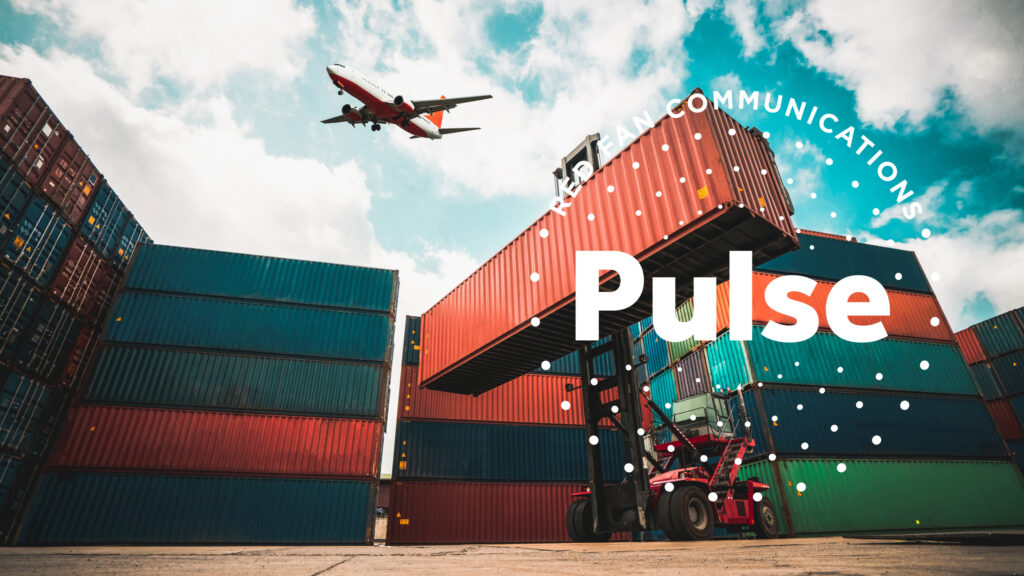
Jacob L. Shapiro is the Founder and Chief Strategist of Perch Perspectives, a human-centric business and political consulting firm. He is also a Partner and Director of Geopolitical Analysis at Cognitive Investments and Geopolitics Editor at Lykeion.
At Red Fan, we are blessed to have a tremendous network of trusted experts we work with to foresee and address issues for our clients. In 2021, we saw human resource and supply chain issues hit companies across the country. Some of those themes have carried over, and 2022 will be an interesting year.
We enter 2022 with supply chain concerns remaining as an intense challenge for companies, so we asked our good friend and geopolitical expert Jacob Shapiro at Perch Perspective. Jacob and his team are brought into company strategy sessions regularly to explore geopolitical concerns that can affect operations, supply chain and even brand reputation. Here’s our interview with Jacob on how supply chain issues will evolve this year.
Supply chain issues were a headache in 2021 and will continue to be so in 2022. But will it be different? How can CEOs think about tackling these issues? Will other countries emerge to provide solutions in 2022?
The silver lining of 2021 was that it affected everyone. Even the best-prepared strategists and supply chain professionals faced serious issues. As the old Mike Tyson saying goes: “Everybody has a plan until they get punched in the mouth.” Well, everyone got punched in the mouth. As a result, 2021 was really about resilience. How fast did you get up off the mat? How creative did you get to solve the crises happening right now? Every week seemed to bring new fires that needed to be put out, so much so that it was impossible to take a step back and think strategically about the future. If 2021 was about resilience, 2022 should be about starting fresh.
2022 is going to have plenty of issues, don’t get me wrong. The kinks that emerged in global supply chains will and have already begun to resolve, but this isn’t going to be a smooth or linear process. And there will always be more fires to put out. Some are predictable, like energy prices continuing to go up due to compressed supply and geopolitical tensions. Some aren’t, like another above-average hurricane season spewing out a storm that makes a particular supply chain seize up, or a drought leading to semiconductor production shortfalls.
My message to CEOs would be to take a deep breath and think beyond your current horizon. Things are never going to “return to normal.” To quote the amazing HBO show “Station Eleven:” “There is no before.” Put out your fires, but make sure you are also setting aside time to strategize for the future. You need to be aware of how supply chains are reforming and how geopolitics is reshaping political relationships and affecting multinational businesses. You need to be mindful of the hidden kinks in your own supply chains, and you need to be investing in contingency plans. No one country or solution is going to emerge to fix your problems. You have to put together the puzzle so that the next time something lands a blow, you are the first one up off the mat.
Will domestic supply chain issues change faster? Everyone seems to look at empty car lots as the indicator and the story is no chips, no cars—but is that really the lipstick test here?
The semiconductor supply chain really is quite brittle and yes, it is one of the key litmus tests for how global supply chains are functioning. So many industries are moving in the direction of automation, Industry 4.0, 5G, artificial intelligence, Internet of Things—all of which need chips. From the farmer, who is betting on installing sensors in the field to use less water and fertilizer, to the manufacturers of electric cars, everyone is affected by this.
From my geopolitical perch, the interconnectedness of global semiconductor supply chains is actually a good thing in the sense that it puts a ceiling on the potential for conflict in the short-term future. China, Taiwan, the U.S., South Korea, Japan—if this supply chain isn’t working, then nothing is working, so there is an incentive to collaborate and a ceiling on the potential for global conflict. But if you’re a supply chain executive, this is enough to make you pull your hair out. Even if there’s some incentive to cooperate now, we’re moving toward a world in which you can’t rely on a single, optimized supply chain and in turn will be forced to navigate complicated regulatory and political concerns to get what you want.
This is not the sort of thing that resolves itself overnight. You can’t build a semiconductor fab in a few months and start pumping out advanced chips. Almost 60 percent of the installed global wafer capacity is located in just three countries: Taiwan, South Korea and Japan. There is literally just one company that makes the EUV lithography systems needed to make the most advanced chips in the world: ASML; and they just had a fire in one of their German factories. And to make matters worse, governments have gotten involved from a national security perspective and are pushing for solutions that aren’t about cost-effectiveness but about ensuring stability and access. We’re talking years of disruption here.
As I said before: you can view this as a catastrophe or as an opportunity. I’d urge folks to think of it as the latter. Everyone is dealing with this. The most important decisions you can make are not how to get what you need six weeks faster this year. It’s how are you preparing to make sure you have a reliable and flexible supply chain for the next three to five years, and to really challenge yourself to see where disruptions might come from for your industry—semis affect the most businesses. Still, there are similar issues throughout global supply chains affecting all sorts of materials and even raw commodities.
Inventories are on the rise and the just-in-time mentality maintains—since inventories are on the rise, will we see a recession in 2022. Who is going to get left holding the bag? If so, when will that happen?
If I could predict the timing of a recession, I probably would have retired by now!
In all seriousness, I think this really boils down to an economics question, namely, is inflation transitory? The reason is simply: inflation is going to drive how the Fed behaves, and the Fed, more than anything else, will determine the timing of a recession. My answer to that question is yes, I think inflation is transitory, but it could last for a bit longer than is generally appreciated.
There are multiple forces affecting inflation. One is just the fall-out from COVID-19. That is beginning to work itself out.
Another is increased energy prices, which is both cyclical and connected to the move toward greener options. That’s a good thing, by the way, and in a few years, we will see the benefits. But in the short term, it’s leading to lots of disruption. Coal prices, for instance, hit record highs in 2021 and I’d expect it to notch new record highs in 2022. That’s not because anyone wants to use coal. It is simply because so much global power production capacity is still reliant on coal, and since no one has been investing in mining coal, you have a shortage that is driving up prices.
Then we’ve got the issue of rebuilding supply chains, which entails everything from building new ships to sourcing raw materials to building new factories and training new labor pools outside of China. There are hidden costs here that make production and transportation more expensive.
And then last but certainly not least, we’ve got something I’ve been banging on the table over since the day the pandemic started: global food prices. They continue to go up, roughly at a 10-year high now. Fertilizer prices are up to, and like semis, they are a brittle supply chain without a lot of hope of substitution in the near term.
So, if inflation is going to continue to go up, even if I think it is “transitory” in the sense that it will last a year or two…the Fed is going to have to raise interest rates. And depending on how much the Fed has to raise interest rates, you could get a recession in the second half of the year. All things being equal, I don’t think that is the most likely scenario. What’s most likely is the Fed raising rates, not so much as to cause a recession, but likely enough that I’d be preparing for it.
Either way, the just-in-time mentality has to die. It’s not going to work in the post-COVID-19 world. I’m not saying indulge in inefficiency, mind you—I’m “just” saying the world is less forgiving than it once was, and this is going to get worse, not better, in the next two to three years.
Deepwater ports seem to be overflowing with containers and the trucking capacity isn’t matching? Will this shake out in 2022? What does this mean for B2B tech companies needing parts? Is this an opportunity for transportation industry leaders?
I don’t think there’s a capacity problem here so much as there is a retention problem. Take trucking, for instance. The problem isn’t a shortage of truckers. The problem is a surplus of truckers, which drives wages down so low, leads to more turn-over, and fosters disillusionment and dissatisfaction in the workforce. Maybe this is the old-fashioned, raised-on-the-farm, “get-off-my-lawn” part of me coming out, but you get what you pay for. If you rethink your transportation problems from “how do I pay the least amount to get things from point A to point B” to “how much do I need to invest in logistics so I can move things from point A to point B quicker and more reliably than my competitors”—I think you’ll win out in the long-run.
What’s going to happen with the international supply chain? Will US companies just start producing parts here and create their own factories? On the other hand, will some industries decide not to go back to international supply partners based on the impact and insist on US-made only?
The world is too interconnected for this to happen overnight. It is going to happen. Indeed, it is already happening in some critical industries which get tied to national security concerns. But for most companies, the issue isn’t as simple as “re-shore to the U.S.” It’s reshore or near-shore with international partners that can follow through on commitments—and have a contingency plan for if something happens that, for whatever reason, makes it harder for that partner to fulfill their commitments. The analogy I’ve been using for this is to think about the world in the 1890s and early 1900s. Everyone at the time knew that geopolitically, things were unstable and that there would probably be a major confrontation at some point. But right up until the eve of World War I, trade and interconnectivity were actually increasing despite hostility and suspicion at the top levels, even between the UK and Germany! I worry about what the world is going to look like for my children, but for the next 10 years, with a few exceptions, I think there are a lot of opportunities internationally for those intrepid enough to reject the easy solution (“just near-shore!”) or to continue with the previous solution (“Made in China!”) and think outside of the box.
Which industries will benefit in 2022 and which will feel the pinch?
The things I am most worried about for 2022 are going to affect us all: energy prices and food prices. Those things obviously affect different industries in different ways. I’m bullish on commodities for the year ahead, so if you’re an energy producer or a farmer, it should be a good year for your bottom line, even if it will be pretty stressful. If, like most clients I work with, you are dependent on energy inputs, or if you’ve got significant staff in a country flashing warning signs for political instability, now is the time to make sure you’re ready for what’s coming.






